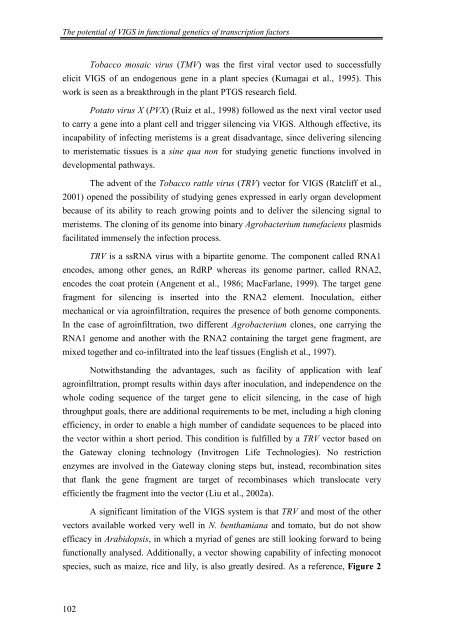Flower development of Lilium longiflorum - The Lilium information ...
Flower development of Lilium longiflorum - The Lilium information ...
Flower development of Lilium longiflorum - The Lilium information ...
You also want an ePaper? Increase the reach of your titles
YUMPU automatically turns print PDFs into web optimized ePapers that Google loves.
<strong>The</strong> potential <strong>of</strong> VIGS in functional genetics <strong>of</strong> transcription factors<br />
Tobacco mosaic virus (TMV) was the first viral vector used to successfully<br />
elicit VIGS <strong>of</strong> an endogenous gene in a plant species (Kumagai et al., 1995). This<br />
work is seen as a breakthrough in the plant PTGS research field.<br />
Potato virus X (PVX) (Ruiz et al., 1998) followed as the next viral vector used<br />
to carry a gene into a plant cell and trigger silencing via VIGS. Although effective, its<br />
incapability <strong>of</strong> infecting meristems is a great disadvantage, since delivering silencing<br />
to meristematic tissues is a sine qua non for studying genetic functions involved in<br />
<strong>development</strong>al pathways.<br />
<strong>The</strong> advent <strong>of</strong> the Tobacco rattle virus (TRV) vector for VIGS (Ratcliff et al.,<br />
2001) opened the possibility <strong>of</strong> studying genes expressed in early organ <strong>development</strong><br />
because <strong>of</strong> its ability to reach growing points and to deliver the silencing signal to<br />
meristems. <strong>The</strong> cloning <strong>of</strong> its genome into binary Agrobacterium tumefaciens plasmids<br />
facilitated immensely the infection process.<br />
TRV is a ssRNA virus with a bipartite genome. <strong>The</strong> component called RNA1<br />
encodes, among other genes, an RdRP whereas its genome partner, called RNA2,<br />
encodes the coat protein (Angenent et al., 1986; MacFarlane, 1999). <strong>The</strong> target gene<br />
fragment for silencing is inserted into the RNA2 element. Inoculation, either<br />
mechanical or via agroinfiltration, requires the presence <strong>of</strong> both genome components.<br />
In the case <strong>of</strong> agroinfiltration, two different Agrobacterium clones, one carrying the<br />
RNA1 genome and another with the RNA2 containing the target gene fragment, are<br />
mixed together and co-infiltrated into the leaf tissues (English et al., 1997).<br />
Notwithstanding the advantages, such as facility <strong>of</strong> application with leaf<br />
agroinfiltration, prompt results within days after inoculation, and independence on the<br />
whole coding sequence <strong>of</strong> the target gene to elicit silencing, in the case <strong>of</strong> high<br />
throughput goals, there are additional requirements to be met, including a high cloning<br />
efficiency, in order to enable a high number <strong>of</strong> candidate sequences to be placed into<br />
the vector within a short period. This condition is fulfilled by a TRV vector based on<br />
the Gateway cloning technology (Invitrogen Life Technologies). No restriction<br />
enzymes are involved in the Gateway cloning steps but, instead, recombination sites<br />
that flank the gene fragment are target <strong>of</strong> recombinases which translocate very<br />
efficiently the fragment into the vector (Liu et al., 2002a).<br />
A significant limitation <strong>of</strong> the VIGS system is that TRV and most <strong>of</strong> the other<br />
vectors available worked very well in N. benthamiana and tomato, but do not show<br />
efficacy in Arabidopsis, in which a myriad <strong>of</strong> genes are still looking forward to being<br />
functionally analysed. Additionally, a vector showing capability <strong>of</strong> infecting monocot<br />
species, such as maize, rice and lily, is also greatly desired. As a reference, Figure 2<br />
102














